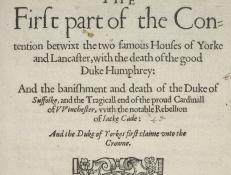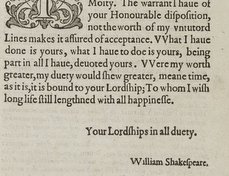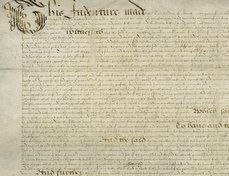Terms of use
The Worshipful Company of Stationers and Newspaper Makers has graciously contributed the above image from their collections to Shakespeare Documented under a Creative Commons Attribution-NonCommercial 4.0 International license. For any further use, visitors should contact the Clerk of the Worshipful Company of Stationers and Newspaper Makers at clerk@stationers.org.
Document-specific information
Creator: Worshipful Company of Stationers and Newspaper Makers
Title: Liber B
Date: 1576-1595
Repository: Worshipful Company of Stationers and Newspaper Makers, London, UK
Call number and opening: Liber B, fol. 305v
Folger Shakespeare Library Staff, "Stationers’ Register entry for Henry VI Part 2," Shakespeare Documented, https://doi.org/10.37078/392.
The Worshipful Company of Stationers and Newspaper Makers, Liber B, folio 305 verso. See Shakespeare Documented, https://doi.org/10.37078/392.
Henry VI Part 2 was entered into Stationer's Liber B on March 12, 1594 as "the firste parte of the Contention of the twoo famous houses of York and Lancaster with the deathe of the good Duke Humfrey and the banishement and Deathe of the Duke of Suffolk and the tragicall ende of the prowd Cardinall of Winchester / with the notable rebellion of Jack Cade and the Duke of Yorkes ffirste clayme vnto the Crowne."
Some may find this play's entry in the register as the "first part" somewhat confusing, given that its modern title is given here as "Part 2." Scholars have disagreed about the exact order of the writing of the plays almost since the study of Shakespeare's works began, but most modern scholars writing on the Henry VI plays—such as Edward Burns, Ronald Knowles, George Taylor, and Michael Taylor—agree that Henry VI Part 1 was authored after Part 2 and Part 3, with all three having been written by 1592 at the latest. In addition to Part 2 being entered as "the firste parte" in the Register, the most compelling evidence for Part 1 having been authored last is that neither Part 2 nor Part 3 refer to the events of Part 1. Secondly, Part 2 lacks some of the most prevalent symbolism that later develops in Part 3, which is also present in Part 1. Finally, Part 2 was never referred to as any kind of a sequel or second part until the printing of the First Folio in 1623, when the text that forms the play as we know it today was printed. The likelihood that Part 1 was conceived of as a prequel appears high.
The precise order of the writing and performance of the plays has been much debated and discussed, and we may never be completely certain as to the exact order in which they were written, as we lack any firmly dateable manuscript copies. In terms of publication, however, Part 2 was entered into the Stationers' Register and printed before any known printed version of Part 1, which appeared for the first time in print in the 1623 First Folio.
Part 2 was entered into the Stationers' Register by Thomas Millington, and the first quarto version was printed by Thomas Creede on Millington's behalf later in 1594. A second edition was printed as a quarto again for Millington in 1600, this time by Valentine Simmes, and was later included in the First Folio in 1623.
Liber B and the other registers with Shakespeare’s works are still kept by the Stationers’ Company in their archives.
[This transcription is pending final vetting]
[Current transcription based on Arber; check back soon for a transcription that conforms to Shakespeare Documented conventions]
Annoque Regni Regine Elizabeth 36
viijo Marcij
John Danter. Entred vnto him for his Copie vnder the
handes of both the Wardens. A booke
intituled. A newe booke of newe conceites vjd
xijo marcij
Thomas myllington / Entred for his copie vnder the handes of
G*S bothe the wardens / a booke
intituled, the firste parte of the
Contention of the twoo famous
houses of York and Lancaster
with the deathe of the good Duke
Humfrey and the banishement
and Deathe of the Duke of Suffolk
and the tragicall ende of the prowd
Cardinall of Winchester / with the
notable rebellion of Jack Cade and
the Duke of Yorkes ffirste clayme vnto
the Crowne . . . . .vjd
xvjto Marcij
John Danter Entred for his Copie vnder the handes of bothe
A. M. aucthore the wardens a booke entituled the nomber
of novelties . . . . vjd
Richard Jones / Entred for his copie vnder the handes of
the wardens, a booke intuled
The most Delectable and famous
historie of the black knight . . . vjd
xxijo Marcij./.
Abell Jeffes./. Entred for his Copie vnder the hande of Mr
Cawood a ballad entituled a moste sweete
songe of an Englishe merchant that killed a
man in Guidine and was for the same
Judged to lose his head and howe in the ende
a mayden saved his lyfe by T. Deloney vjd R
John Jagger Entred for his Copie vnder the handes of
Mr Hartwell and the Wardens. A
booke entytuled. The manner howe to
handle weaponns safely, aswell offensive
as defensive. &c by master Giacomo di
Gressi . . . . vjd./
Sources
Edward Arber, ed., A Transcript of the Registers of the Company of Stationers of London: 1554–1640 A.D. 5 vols. (London: privately printed, 1875–94), 2:646.
Martin Wiggins and Catherine Richardson, "888. The First Part of the Contention betwixt the Two Famous Houses of York and Lancaster," in British Drama, 1533-1642: A Catalogue. Vol. 3, 1590-1597 (Oxford: Oxford University Press, 2013), 92-103.
Last updated February 8, 2020











